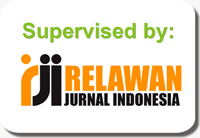Identifikasi Tingkat Pengangguran Terbuka Berdasarkan Kecamatan Di Kabupaten Pekalongan Menggunakan Spatial Model
DOI:
https://doi.org/10.31961/eltikom.v5i2.337Keywords:
moran's index, open unemployment rate, Pekalongan, spatialAbstract
Unemployment is an economic problem that the central and regional governments must resolve comprehensively and integrated. The open unemployment rate in Pekalongan Regency in the last three years has increased. It is influenced by several factors, one of which is the population growth rate. Likewise, the labor force participation rate has increased. It shows that the increasing availability of the workforce is not accompanied by additional employment and is not proportional to population growth. This study aims to determine the level of open unemployment and labor force participation in the sub-district, whether there is a relationship and mutual influence between sub-districts in Pekalongan Regency. The method used to see the correlation between sub-districts is the spatial analysis method. The method used to analyze the correlation between regions is the Moran's Index and the Moran Scatterplot, while to prove the dependence or spatial effect between regions partially used the LISA test. The test results show the Moran Index for the open unemployment rate of 0,915 and the labor force participation rate of 0,737 with a significance level of 5%. This measurement value shows that the Moran index value is close to 1, which means autocorrelation between neighboring sub-districts on the open unemployment rate and the labor force participation rate. While the LISA test results show that there are seven spatially related H-H districts, meaning that there is a strong correlation between the observed sub-districts and the surrounding districts. The strong correlation between observation sub-districts and their surroundings can be used as a reference for making policies in overcoming open unemployment between sub-districts. The policy for handling open unemployment has become more comprehensive and integrated among sub-districts by seeing that each sub-district has a spatial correlation and affects open unemployment in the district.
Downloads
References
F. Mulyani, “Determinan Kemiskinan di Kawasan Timur Indonesia (KTI) Tahun 2015 Menggunakan Metode Geographically Weighted Regression (GWR),†Jakarta, 2015.
W. I. Astuti, V. Ratnasari, and W. Wibowo,.“Analisis Faktor yang Berpengaruh Terhadap Tingkat Penganguran Terbuka di Provinsi Jawa Timur Menggunakan Regresi Data Panel,†J. Sains dan Seni ITS, vol. 6, no. 1, pp. 144–149, 2017, doi: 10,12962/j23373520,v6i1.22977.
P. J. T. BPS, Jawa Tengah Dalam Angka 2019. Semarang: BPS. Propinsi Jawa Tengah, 2020,
K. P. BPS, Kabupaten Pekalongan Dalam Angka 2019. Pekalongan: BPS. Kabupaten Pekalongan, 2020,
H. Harmes, B. Juanda, E. Rustadi, and B. Barus, “Pemetaan efek spasial pada data kemiskinan Kota Bengkulu,†J. Reg. Rural Dev. Plan., vol. I, no. 2, pp. 192–201, 2017, doi: 10,29244/jp2wd.2017.1.2.192-201.
Mariana, Pendekatan Regresi Spasial dalam Pemodelan Tingkat Pengangguran Terbuka. Bogor: Sekolah Pascasarjana IPB, 2012.
R. Rahmawati, D. Safitri, and O. U. Fairuzdhiya, “Analisis Spasial Pengaruh Tingkat Pengguran terhadap Kemiskinan di Indonesia,†Media Stat., vol. 8, no. 1, pp. 23–30, 2015.
A. Y. Mahihody, D. S. Engka, and A. Y. Luntungan, “Pengaruh upah dan IndeksPem bangunan Manusia (IPM) terhadap pengangguran di Kota Manado,†J. Berk. Ilm. Efisiensi, vol. 18, no. 3, pp. 24–34, 2018.
H. S. Karaalp-Orhan and F. E. Gulel, “Regional unemployment in Turkey: A spatial panel data analysis,†J. Soc. Secur., vol. 6, no. 2, pp. 47–67, 2016.
L. Kurniasari and A. E., “Analisis Spasial Untuk Mengidentifikasi Tingkat Pengangguran Terbuka Berdasarkan Kabupaten/Kota di Pulau Jawa Tahun 2017,†Indones. J. Stat. Its Appl., vol. 3, no. 3, pp. 202–215, 2019.
A. P.. Taryono, D. Ispriyanti, and A. Prahutama, “Analisis Faktor yang mempengaruh Penyebaran Penyakit Demam Berdarah Dengue (DBD) di Provinsi Jawa Ten-gah dengan metode spasial Autoregresive Model dan Spasial Durbin Eror Model,†Indones. J. Appl. Stat., vol. I, no. 1, pp. 1–13, 2018.
Y. M. Zhukov, Applied Spatial Statistics in R, Spatial Regression. Cambrigde, MA: Harvard University, 2010,
S. Mariani, Wardono, Masrukan, and F. Fauzi, “The ArcVIEW and GeoDa Application in Optimization of Spatial Regression Estimate,†J. Theor. Appl. Inf. Technol., vol. 95, no. 6, pp. 1286–1299, 2017.
L. Anselin, Spatial Data Analysis with GIS: An Introduction to Application in The Social Sciences. California: University of California Santa Barbara, 2012.
Downloads
Published
How to Cite
Issue
Section
License
All accepted papers will be published under a Creative Commons Attribution 4.0 International (CC BY 4.0) License. Authors retain copyright and grant the journal right of first publication. CC-BY Licenced means lets others to Share (copy and redistribute the material in any medium or format) and Adapt (remix, transform, and build upon the material for any purpose, even commercially).




